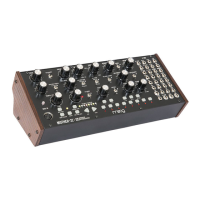18
UNDERSTANDING & USING THE MOTHER-32 SEQUENCER
BASIC CONCEPTS
A sequencer is used to play notes or rests on a synthesizer from a pattern in memory, typically
at a steady tempo. Each note or rest in the pattern is called a “step”.
On each step, the sequencer outputs a CV signal to control the VCO, a Gate signal to trigger the EG,
and if desired, an Accent signal which modulates the VCF and VCA for emphasizing notes. Other than
that, the sound you hear from the Mother-32 when using the sequencer is determined by the front
panel controls and any patch cables in use on the patchbay.
Each pattern can be up to 32 Steps in length, and up to 64 patterns can be stored in memory.
SEQUENCER MODES
The Mother-32 sequencer has two modes of operation: KB (Keyboard) and STEP (Step Edit).
KB MODE (DEFAULT)
KB mode is for playing directly from the panel,
entering/editing notes in a pattern using the
Record function, and transposing patterns
during Sequencer playback.
Press (SHIFT)+(KB) to select KB mode.
STEP MODE
Step mode is for interacting with a pattern by enabling,
muting and editing steps, even during playback.
Press (SHIFT)+(STEP) to select Step mode.
Both modes work with any pattern, and modes can be changed at any time.
NOTE: If you are new to sequencers, use KB mode and its Record function to get started.
+
+

